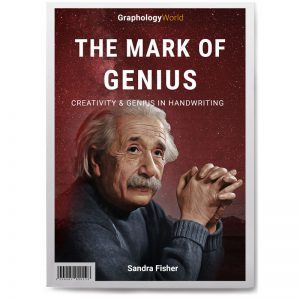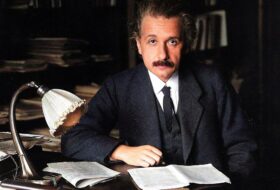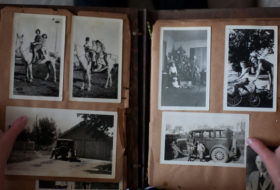Long before the popular movie, “The Imitation Game” came out I decided to feature Alan Turing and his handwriting as one of the geniuses in my book “The Mark of Genius.”
At the time I was unable to find any examples of Alan Turing’s handwriting but what I did find was an online version of an amazingly descriptive and fascinating biography of Alan Turing. It was “The Alan Turing Internet Scrapbook” and the author was Andrew Hodges.
Now here’s the fascinating part. This remarkable biographical work is coupled with Andrew Hodges’s book, The Enigma which was eventually to be the basis for the award winning movie “The Imitation Game.”
But I wasn’t to know this at the time. Nevertheless, I did want to feature Alan Turing’s handwriting in my book so I wrote to Andrew Hodges to ask if he would allow me to use two of the handwriting illustrations for my forthcoming book.
Professor Hodges replied with a very kind and friendly email in which he graciously agreed to my request.
In retrospect, this was a rather remarkable communication. You see, I had previously received a number of refusals from certain libraries for permission to reproduce Turning’s handwriting. Here at last was a positive reply.
But in addition to that, neither he nor I knew that his book was destined for Hollywood stardom!
The instant success of the movie is now legend. But there’s more!
Turing’s Manuscripts are worth a fortune
A few years ago, a certain manuscript by Turing was sold to an anonymous buyer for over a million dollars.
But now there is a new 56 page manuscript in a notebook that has just been discovered and it is expected to go on auction at Bonhams in New York. This manuscript is also expected to fetch seven figures. As explained in the article:
“From internal evidence, it dates from 1942 when he was working at Bletchley Park to break the German Enigma Code, and provides remarkable insight into the thought process of a genius.”
Here is a nice reproduction of a small section of his handwriting from the same article:

And now for your interest, here is an excerpt from my book, “The Mark of Genius” in which I discussed Turing’s handwriting.
Alan Turing – A Genius and Founder of the Information Age
Alan Turing had a brilliant mind but somehow his contribution to mathematics and computer science was never given sufficient credit.
In fact he was an amazing man and our world today would probably be very different had it not been for his passion for codes and computers. A mathematical genius, he was as unique in his thinking as he was in his lifestyle. For he was shy, moody and eccentric.
Born in London in 1912 and educated at Cambridge, Turing became an accomplished mathematician. Not only was he the founder of computer science but he also laid the foundations for the study of artificial intelligence.
He was an expert cryptologist and decipherer of codes. In World War 11 he was responsible for deciphering secret German U-boat communications. And as a direct result of this, it is said that he shortened the length of the war by several years.
He became interested in a study comparing the power of computation with the power of the human brain. His ambition was to create an electronic computer.
Following are two samples of Alan Turing’s handwriting from the biography by Professor Andrew Hodges reproduced by kind permission of the author.
The first sample was written after the death of his friend Christopher Morcom whom he deeply loved. Very affected by his friends death, Turing was moved to write “Nature of Spirit” in which he expressed his thoughts about life after death.
Alan Turing’s Handwriting
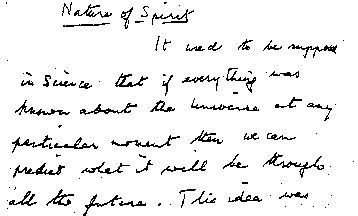
Andrew Hodges explains: “In 1932, on a visit to the Morcom family home, he wrote out a statement of belief in the survival of the spirit after death which brought in an appeal to the new science of quantum mechanics. ”
At the very first glance we can clearly see the sensitivity that shows his barometer-like receptivity to the vibrations of the world.
The small size of the writing and the thin, rather fine line with a touch of roundness all show gentle sensitivity. There is a tremulous, electric movement that speaks of swift intelligence and emotional susceptibility.
Indeed we see that his moods played fast and loose with him; sometimes buoyant and at other times depressed. The rising and falling lines of our first sample attest to his rather erratic moods.
And here is another sample.
A Poem in Alan Turing’s handwriting
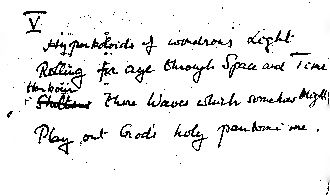
The Signs of Genius
There is much evidence of his quick and agile mind in the small but clear handwriting, the sharp tiny angles and the clarity of the words and lines.
The capitals are printed showing a creative approach. T-bars are strong, high and visionary. It is as if he knew that he could bring into reality anything that he could conceptualize.
In addition to the signs of an acute mind in Alan Turing’s handwriting, our second sample shows some moodiness in the richer ductus and the dark crossing out of the first word of the third line.
Notice also the wide spacing between the lines. This together with the small writing shows his introversion and inherent loneliness.
In this handwriting we become aware of a certain elegance that is particularly obvious in the second sample; an elegance that no doubt found expression in his brilliant calculations and mathematical genius.
Look at the first word “Hyperbaloid” in the first line and “Rolling” in the second line – both exemplify elegance and simplicity.
Indeed, there is an almost childlike simplicity about his handwriting. You sometimes find this in people who are not pretentious.
And yet so much precedence has been given to the sadness and mystery in Turing’s life because of his homosexuality. It is known that he accepted hormone treatment to “cure” his homosexuality. The debate still rages as to whether he committed suicide or not in 1954.
Be that as it may, one fact is certain. If not for Turing the world war would have raged on for several more years with so much more loss of life and destruction.
He literally changed the course of history – not only by shortening a devastating world war but also by being one of the most important innovators in our present information age.
From “The Mark of Genius”


